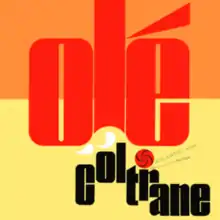Olé Coltrane
Olé Coltrane is the ninth album by jazz musician John Coltrane, released in 1961 on Atlantic Records, catalogue SD 1373. The album was recorded at A&R Studios in New York, and was the last of Coltrane's Atlantic albums to be made under his own supervision.
| Olé Coltrane | ||||
|---|---|---|---|---|
 | ||||
| Studio album by | ||||
| Released | First week of November 1961[1] | |||
| Recorded | May 25, 1961 | |||
| Studio | A&R Studios, New York City | |||
| Genre | Modal jazz | |||
| Length | 36:50 original LP 45:50 CD reissue | |||
| Label | Atlantic SD 1373 | |||
| Producer | Nesuhi Ertegun | |||
| John Coltrane chronology | ||||
| ||||
| Review scores | |
|---|---|
| Source | Rating |
| Allmusic | |
| Down Beat | |
| The Penguin Guide to Jazz | |
| The Rolling Stone Jazz Record Guide | |
Background
Two days prior to the recording of Olé Coltrane, Coltrane had made Africa/Brass, his inaugural recording session for his new label, Impulse! Records, at the new Van Gelder Studio in Englewood Cliffs, New Jersey.[6] With one further album due his old label Atlantic, he brought in his working quintet along with two participants in the Africa/Brass sessions, Art Davis and Freddie Hubbard.[7] Owing to his concurrent contract with Prestige Records, Eric Dolphy was listed on the credits under the pseudonym George Lane.[8]
Coltrane's interest in the music of Spain evident in "Olé", may have been spurred by his ex-employer Miles Davis's Sketches of Spain from the previous year.[9] The structure and melody of the modal jazz vamp "Olé" was borrowed from the Spanish folk song El Vito (maybe better known as El Quinto Regimiento from the Spanish Civil War (also known as Venga Jaleo), which was made known by Pete Seeger), while the soprano saxophone work recalled 1961's "My Favorite Things".
The titles for the songs on side two reflect the band's continued interest in African forms as expressed on the May 23 Africa/Brass recordings. McCoy Tyner commented: "On 'Dahomey Dance' [Coltrane] had a record of these guys who were from Dahomey, which is why he used two bassists. He showed that rhythm to Art Davis and Reggie Workman. So the influence was there."[10]
On September 19, 2000, Rhino Records reissued Olé Coltrane as part of its Atlantic 50th Anniversary Jazz Gallery series. Included was a single bonus track which had appeared on The Heavyweight Champion: The Complete Atlantic Recordings in 1995.
Track listing
Side one
| No. | Title | Writer(s) | Length |
|---|---|---|---|
| 1. | "Olé" | John Coltrane | 18:17 |
Side two
| No. | Title | Writer(s) | Length |
|---|---|---|---|
| 1. | "Dahomey Dance" | John Coltrane | 10:53 |
| 2. | "Aisha" | McCoy Tyner | 7:40 |
1989 reissue bonus track
| No. | Title | Writer(s) | Length |
|---|---|---|---|
| 4. | "To Her Ladyship" | Billy Frazier | 8:54 |
Personnel
- John Coltrane — soprano saxophone on "Olé" and "To Her Ladyship"; tenor saxophone on "Dahomey Dance" "Aisha" and second part of To Her Ladyship
- Freddie Hubbard — trumpet
- Eric Dolphy — flute on "Olé" and "To Her Ladyship"; alto saxophone on "Dahomey Dance" and "Aisha"
- McCoy Tyner — piano
- Reggie Workman — bass on "Olé," "Dahomey Dance" and "Aisha"
- Art Davis — bass on "Olé," "Dahomey Dance" and "To Her Ladyship"
- Elvin Jones — drums
Production personnel
- Nesuhi Ertegun — production
- Phil Ramone — engineering
- Jagel & Slutzky Graphics — cover design
- Ralph J. Gleason — liner notes
- Patrick Milligan — reissue supervision
- Dan Hersch — digital remastering
- Rachel Gutek — reissue design
- Sevie Bates — reissue art direction
- Neil Tesser — reissue liner notes
- Vanessa Atkins — reissue editorial supervision
- Shawn Amos — reissue editorial coordination
Influence
Olé has also been performed and recorded by Noah Howard on his live albums Live In Europe, Vol. 1 (1975) and Berlin Concert (1977) and by Coltrane's later sideman Pharoah Sanders, on his live album Heart is a Melody from 1982.
References
- Billboard Nov 6, 1961
- Olé Coltrane at AllMusic
- Down Beat: February 1, 1962 vol. 29, no. 3
- Cook, Richard; Morton, Brian (2008). The Penguin Guide to Jazz Recordings (9th ed.). Penguin. p. 287. ISBN 978-0-141-03401-0.
- Swenson, J., ed. (1985). The Rolling Stone Jazz Record Guide. USA: Random House/Rolling Stone. p. 47. ISBN 0-394-72643-X.
- Lewis Porter. John Coltrane: His Life and Music. Ann Arbor: The University of Michigan Press, 1999. ISBN 0-472-10161-7, p. 364.
- ''Olé Coltrane. Rhino R2 79965, liner notes, pp. 2-4.
- Porter, p. 212
- Porter, p. 212
- Watrous, Peter (1993). "John Coltrane: A Life Supreme". In Rowland, Mark; Scherman, Tony (eds.). The Jazz Musician. St. Martin's Press. pp. 177–178.